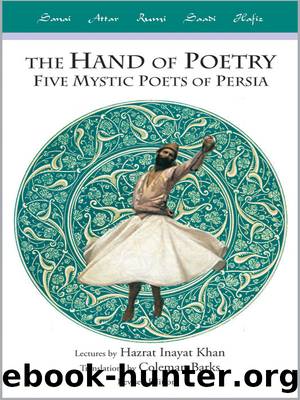Hand of Poetry by Barks Coleman

Author:Barks, Coleman [Hazrat Inayat Khan, Coleman Barks]
Language: eng
Format: epub
Publisher: Omega Publications, Inc.
Published: 2011-12-15T00:00:00+00:00
RUMI
BIRDSONG MOVING
THROUGH US LIKE RAIN
Translations by
Coleman Barks
Translatorâs Introduction
Unlike other figures in this collection, Rumiâs life is well documented. A hundred and forty-seven personal letters have survived! I wonât try to retell the external sequence of his famous life-story here. He came of a spiritually illustrious line. His father Bahauddin was also a powerfully original mystic. In the Maarif, a kind of visionary diary, the father describes how God would kiss and absorb him like a lover in the night. Rumiâs own realization of nearness is the most authentic region of his life. Outer events to a mystic are not nearly so salient as the inner changing. Not the poetry, nor the turn, no action is so important as Rumiâs openhearted emptiness. There was the long conversation with Shams (sohbet is the Turkish word, toucher lâessence in French; they were together at the core of being); then the separation, and the continued âtalkingâ in the poetry. Rumi endured a presence beyond the personal. Some go silent at that point. Others can only breathe Allah, Allah. Rumi, though, was still in command of a full cultural orchestra, all instruments intact.
Several poems here mention the reed flute. Rumi has what amounts to a theory of language associated with this instrument. The reed flute says one thing through its empty cane center: I want to go back to the canebrake. No matter how intricate it gets, Rumi says, language underneath all its sounds is the one hollow resonance of separation, the wail of the human condition at being uprooted from the whole. This is a truth and a puzzlement to Rumi. Why isnât there a double note, he wonders, along with the complaint, a strand of praise for the skill of the craftsman who not only plucked the reed from the reedbed, but also fashioned the bare cylinder into a ney, the human form with its nine holes.
The poems here include examples of most of the forms that Rumi worked in. Some quatrains (the short poems), two ghazals (the intermediate length odes), a wedding piece, one prose segment from the Discourses, and several longer pieces from the Mathnawi, the incomparable fifty-two thousand line work which Rumi dictated to Husam, his scribe, for the last twelve years of his life.
The story from the Discourses is one that Shams of Tabriz told. Shams was Rumiâs teacher and his door into presence. They met on a street in Konya. Shams asked, âWho is greater, Bastami or Muhammed, for Bastami said, âHow great is my glory!â and Muhammed said, âWe do not praise You as You should be praised.ââ Rumi felt the depth the question came from and fell off the donkey he was riding. Reviving, he answered, âMuhammed is greater, because Bastami took one gulp and his thirst was quenched. Whereas for Muhammed the Way was continually unfolding.â Shams realized that he had found the companionship heâd been searching for his entire life. The mystery of their Friendship is the source and the subject of the poetry.
Coleman
Download
This site does not store any files on its server. We only index and link to content provided by other sites. Please contact the content providers to delete copyright contents if any and email us, we'll remove relevant links or contents immediately.
Anxious People by Fredrik Backman(2510)
The Last Thing He Told Me by Laura Dave(2165)
The Soulmate Equation by Christina Lauren(1888)
Not a Happy Family by Shari Lapena(1555)
Romancing Mr. Bridgerton (Bridgerton 04) by Julia Quinn(1500)
Slough House by Mick Herron(1388)
Life's Too Short by Abby Jimenez(1371)
The Switch by Beth O'Leary(1364)
Kiss My Cupcake by Helena Hunting(1323)
Solutions and Other Problems by Allie Brosh(1295)
Mordew by Alex Pheby(1247)
This Time Next Year by Sophie Cousens(1174)
A Rogue of One's Own by Evie Dunmore(1094)
No One Is Talking About This by Patricia Lockwood(1057)
The Mary Shelley Club by Goldy Moldavsky(1036)
Playing Nice by JP Delaney(1019)
Roadside Picnic by Arkadi & Boris Strugatsky(991)
Squeeze Me: A Novel by Carl Hiaasen(988)
Quinoterapia by Quino(976)
